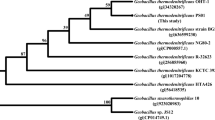Abstract
The thermostable esterase from the thermophilic bacterium Clostridium thermocellum DSM 1313 was expressed in Escherichia coli and purified by Ni2+ affinity chromatography. Its molecular weight was approximately 35 kDa according to 12 % sodium dodecyl sulfate-polyacrylamide gel electrophoresis (SDS-PAGE) analysis. The enzyme exhibited the highest specific activity with p-nitrophenyl butyrate (285 s−1 mM−1). The activity of the esterase was greatest at 65 °C, and the esterase maintained residual activity levels of 70 and 50 % after 3 h incubation at 65 and 70 °C, respectively. Its activity was optimal at pH 7.0, was enhanced in the presence of Ca2+ and Mg2+, and was inhibited by Ni2+ and Cu2+. The addition of surfactants, such as Tween-20, Tween-80, Triton X-100, and SDS, at concentrations of 5 % (v/v) significantly inhibited the lipolytic action of the esterase. Enzyme activity was relatively stable in 10 % methanol, and 50 % residual activity was seen in 10 % DMSO, demonstrating its potential in biodiesel production and industrial applications.




Similar content being viewed by others
References
Gertie van Pouderoyen, T. E., Jaeger, K.-E., & Dijkstra, A. B. W. (2001). The crystal structure of bacillus subtilis lipase—a minimal α/β hydrolase fold enzyme. Journal of Molecular Biology, 309, 215–226.
Holmquist, M. (2000). Alpha beta-hydrolase fold enzymes structures, functions and mechanisms. Current Protein and Peptide Science, 1, 209–235.
Akoh, C. C., Lee, G. C., Liaw, Y. C., Huang, T. H., & Shaw, J. F. (2004). GDSL family of serine esterases/lipases. Progress in Lipid Research, 43, 534–552.
Karl-Erich Jaeger, T. E. (2002). Lipases for biotechnology. Current Opinion in Biotechnology, 13, 390–397.
Mathew, S. M. S., & Abraham, T. E. (2004). Ferulic acid: an antioxidant found naturally in plant cell walls and feruloyl esterases involved in its release and their applications. Critical Reviews in Biotechnology, 24, 59–83.
Jaeger, K.-E., & Reetz, M. T. (1998). Microbial lipases form versatile tools for biotechnology. TRENDS in Biotechnology, 16, 396–403.
Levisson, M., van der Oost, J., & Kengen, S. W. (2007). Characterization and structural modeling of a new type of thermostable esterase from Thermotoga maritima. FEBS Journal, 274, 2832–2842.
Kakugawa, S., Fushinobu, S., Wakagi, T., & Shoun, H. (2007). Characterization of a thermostable carboxylesterase from the hyperthermophilic bacterium Thermotoga maritima. Applied Microbiology and Biotechnology, 74, 585–591.
Tao, W., Shengxue, F., Duobin, M., Xuan, Y., Congcong, D., & Xihua, W. (2013). Characterization of a new thermophilic and acid tolerant esterase from Thermotoga maritima capable of hydrolytic resolution of racemic ketoprofen ethyl ester. Journal of Molecular Catalysis B: Enzymatic, 85–86, 23–30.
Yang, S.-Q., Tang, L., Yan, Q.-J., Zhou, P., Xu, H.-B., Jiang, Z.-Q., & Zhang, P. (2013). Biochemical characteristics and gene cloning of a novel thermostable feruloyl esterase from Chaetomium sp. Journal of Molecular Catalysis B: Enzymatic, 97, 328–336.
Kamzolova, S. V., Finogenova, T. V., Lunina, Y. N., Perevoznikova, O. A., Minachova, L. N., & Morgunov, I. G. (2007). Characteristics of the growth on rapeseed oil and synthesis of citric and isocitric acids by Yarrowia lipolytica yeasts. Microbiology, 76, 20–24.
Yang, L., Huo, D., He, K., Zhang, S., & Hou, C. (2013). Role of tryptophan in the active site of plant esterase: chemical modification and fluorometric studies. Applied Biochemistry and Biotechnology, 170, 909–924.
Zhang, S., Wu, G., Feng, S., & Liu, Z. (2014). Improved thermostability of esterase from Aspergillus fumigatus by site-directed mutagenesis. Enzyme and Microbial Technology, 64–65, 11–16.
Yan, Q. J., Yang, S. Q., Duan, X. J., Xu, H. B., Liu, Y., & Jiang, Z. Q. (2014). Characterization of a novel hormone-sensitive lipase family esterase from Rhizomucor miehei with tertiary alcohol hydrolysis activity. Journal of Molecular Catalysis B: Enzymatic, 109, 76–84.
Winkler, U. K., & Stuckmann, M. (1979). Glycogen, hyaluronate, and some other polysaccharides greatly enhance the formation of exolipase by Serratia marcescens. Journal of Bacteriology, 138, 663–670.
Zhang, S., Wu, G., Feng, S., & Liu, Z. (2014). Improved thermostability of esterase from Aspergillus fumigatus by site-directed mutagenesis. Enzyme and Microbial Technology, 64, 11–16.
Demirjian, D. C., Morἱs-Varas, F., & Cassidy, C. S. (2001). Enzymes from extremophiles. Current Opinion in Chemical Biology, 5, 144–151.
Fuciños, P., Atanes, E., López-López, O., Solaroli, M., Cerdán, M. E., González-Siso, M. I., Pastrana, L., & Rúa, M. L. (2014). Cloning, expression, purification and characterization of an oligomeric His-tagged thermophilic esterase from Thermus thermophilus HB27. Process Biochemistry, 49, 927–935.
López, G., Chow, J., Bongen, P., Lauinger, B., Pietruszka, J., Streit, W. R., & Baena, S. (2014). A novel thermoalkalostable esterase from Acidicaldus sp. strain USBA-GBX-499 with enantioselectivity isolated from an acidic hot springs of Colombian Andes. Applied Microbiology and Biotechnology, 98, 8603–8616.
Tao, W., Shengxue, F., Duobin, M., Xuan, Y., Congcong, D., & Xihua, W. (2013). Characterization of a new thermophilic and acid tolerant esterase from Thermotoga maritima capable of hydrolytic resolution of racemic ketoprofen ethyl ester. Journal of Molecular Catalysis B: Enzymatic, 85, 23–30.
Rao, L., Xue, Y., Zheng, Y., Lu, J. R., & Ma, Y. (2013). A novel alkaliphilic Bacillus esterase belongs to the 13th bacterial lipolytic enzyme family. PloS One, 8, e60645.
Xue, Y., Zhang, J., Wu, X., Sun, H., & Xu, C. (2012). Cloning, expression and characterization of a novel esterase from Bacillus pumilus. Annals of Microbiology, 63, 879–885.
Kim, Y.-O., Park, I.-S., Kim, H. K., Nam, B. H., Kong, H. J., Kim, W. J., Kim, D. G., Kim, B. S., Jee, Y. J., & Song, J. H. (2013). Shewanella sp. Ke75 esterase with specificity for p-nitrophenyl butyrate: gene cloning and characterization. Journal of the Korean Society for Applied Biological Chemistry, 56, 55–62.
Arpigny, J., & Jaeger, K. (1999). Bacterial lipolytic enzymes: classification and properties. The Biochemical Journal, 343, 177–183.
Ogino, H., Miyamoto, K., & Ishikawa, H. (1994). Organic-solvent-tolerant bacterium which secretes organic-solvent-stable lipolytic enzyme. Applied and Environmental Microbiology, 60, 3884–3886.
Mei, Y., Peng, N., Zhao, S., Hu, Y., Wang, H., Liang, Y., & She, Q. (2012). Exceptional thermal stability and organic solvent tolerance of an esterase expressed from a thermophilic host. Applied Microbiology and Biotechnology, 93, 1965–1974.
Acknowledgments
This work was supported by the National Key Basic Research Program of China (973 Program, No. 2011CBA00800), the Open Funding Project of National Key Laboratory of Biochemical Engineering, and the Key Agriculture Support Project of Jiangsu Province, China (No. BE2013400).
Author information
Authors and Affiliations
Corresponding author
Rights and permissions
About this article
Cite this article
Zhang, T., Chen, H., Ni, Z. et al. Expression and Characterization of a New Thermostable Esterase from Clostridium thermocellum . Appl Biochem Biotechnol 177, 1437–1446 (2015). https://doi.org/10.1007/s12010-015-1824-7
Received:
Accepted:
Published:
Issue Date:
DOI: https://doi.org/10.1007/s12010-015-1824-7




